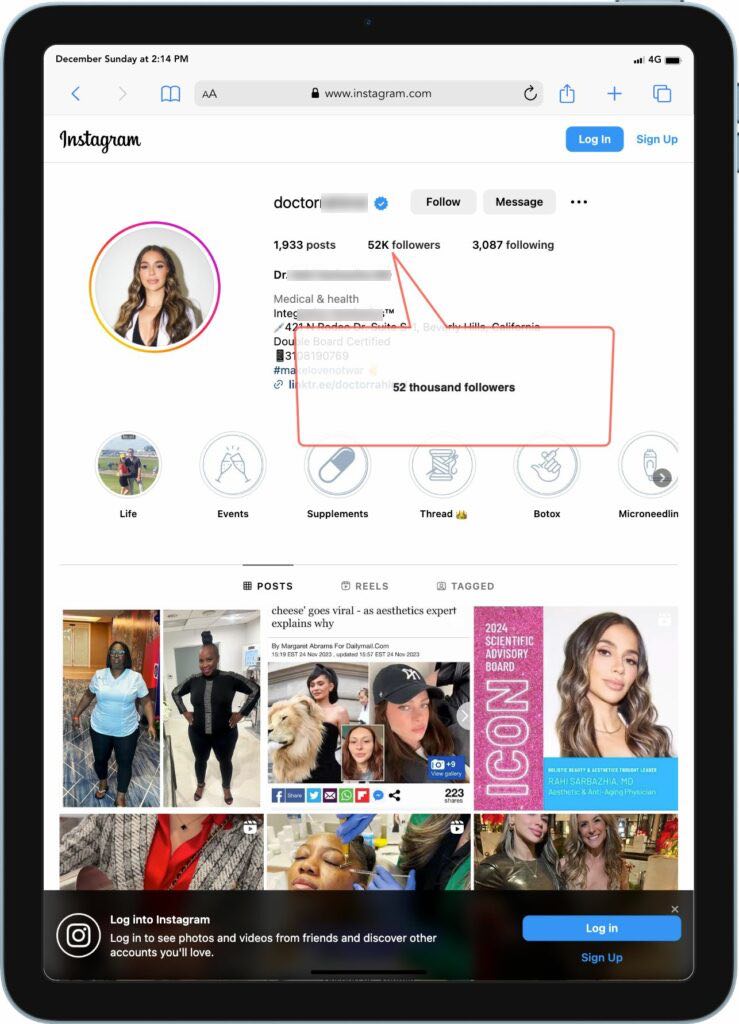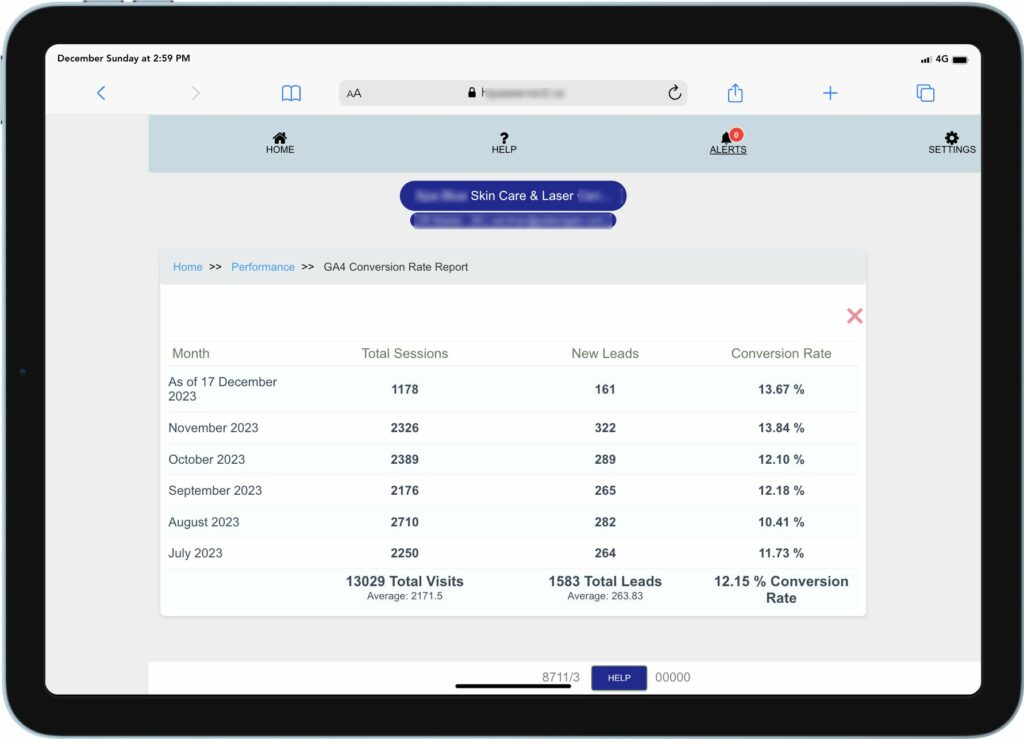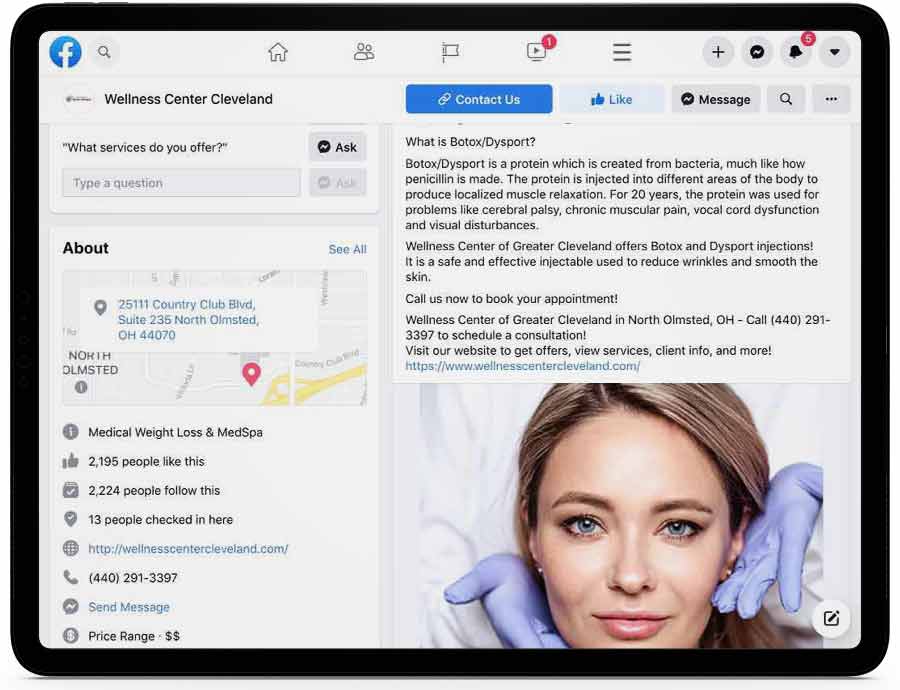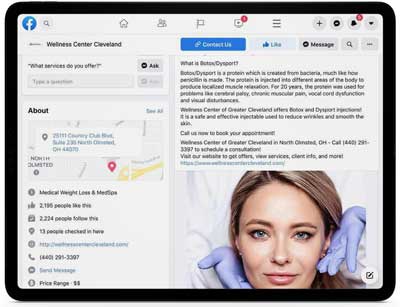How to Acquire New Patients Using Social Media
Common question from practice managers of medical and dental practices : How many posts should be posted on social media for a medical practice per month?
A medical practice should aim to post between 16 to 20 times per month on social media, which translates to roughly 4 posts per week across their chosen platforms, depending on the platform and their audience engagement levels.
However, consistency is key:
Posting regularly, even if it’s just a few times a week, is more impactful than sporadic posting.
Platform specific frequency:
Platforms like IG might require more frequent posts due to their fast-paced nature, while Facebook might be suitable with fewer posts per week.
Quality over quantity:
Focus on creating valuable and informative content relevant to your patients rather than just posting for the sake of posting.
How can a medical practice create engaging social media content for its channels?
There are 2 main strategies:
1) Paid advertising – This is quick and effective, however it is expensive. Read more about ROI from social ads.
Example of social media ad: This is a video ad on Meta (Facebook, Instagram) . It targets medical weight loss from an MD in Florida. Key focus is the benefits and then there is an “Offer” and also the fact that it is real doctor not a tele medicine practice. Medical practices with physical local location for weighlt loss have a much higher conversion rate than an online practice.

2) Organic social presence – This takes a very long time to establish and requires constant commitment of adding fresh and useful content for your target audience. For example, here is a provider with 52 thousand followers on Instagram. Imagine if you had these followers, you would think if you post on your account, all of the followers will get your post. Not so. You still need to boost your posts to reach your followers.

One of the main overlooked task by medical, dental and medspa providers is that they don’t actually track conversions.
In the example below, in the month of November, there are 2326 actual sessions (sessions are defined by Google analytics version 4) as actual human beings, not bots. From these 2326 sessions, 322 clients contacted the practice ( and clicked on that they are “New” client rather than a returning existing patient). What this means is that in the month of the conversion rate is 13.84 percentage. Which far exceeds the industry average. Read more here.

Posting content on social media is straightforward, and social media channels make it only a click away for their users, including medical practices, to post online. As easy as it is posting things on social media channels, developing new and engaging content continuously takes time. Many medical practices find it challenging, and as a result, a daily post soon becomes a weekly post, and then a weekly post soon becomes a monthly or every other month post. Social media is a big part of many people’s lives, and more than half of the population accesses social media at least once a day and spend over 2 hours on social media channels. A medical practice has a lot of competition for the attention of these viewers, so they need to put extra effort into their content to get the attention of potential patients.
As mentioned before, creating content is easy. However, consistently creating content that engages with a target audience can take time and effort. A medical practice is not only competing with other practices for the attention of potential patients but also against other things on social media, like funny cat videos and links to stories about celebrity gossip. Content posted by a medical practice will compete against these posts, other practices, and many other things. Below are some great tips to follow when a medical practice wants to create engaging content for their social media channels


Examples of social media strategies for doctors, categorized by platform and goals:
How to Acquire New Patients Using Social Media: Platform-Specific Strategies
Social media platforms provide unique opportunities to attract new patients to your practice. By tailoring your approach to each platform’s strengths, you can effectively connect with your target audience and grow your patient base. Here’s how to leverage the most popular platforms for acquiring new patients:
1. Instagram
Instagram is ideal for visually showcasing your services and engaging with a younger, image-focused audience. Instagram’s visual nature allows you to build credibility and attract patients who value aesthetics and wellness.
Strategies:
- Before-and-After Photos: Post high-quality images (with patient consent) to demonstrate the effectiveness of your treatments.
- Reels and Stories: Share short, engaging videos explaining procedures or showcasing your facility.
- Educational Posts: Create carousel posts or infographics on topics like skincare, anti-aging, or health tips.
- Collaborate with Influencers: Partner with local influencers to promote your services.
- Use Hashtags: Include hashtags like #MedicalSpa, #PrimaryCare, or #[YourLocation] to increase discoverability.
- Host Contests: Offer free consultations or discounts in exchange for likes, shares, and follows.
2. Facebook
Facebook is a versatile platform for connecting with a broad audience, including families and local communities. Facebook’s targeting capabilities and community engagement features help you reach local audiences effectively.
Strategies:
- Targeted Ads: Use Facebook Ads Manager to run location-based ads targeting demographics relevant to your practice (e.g., families, seniors, or young professionals).
- Engage in Local Groups: Join and participate in local community groups to answer health-related questions and promote your practice subtly.
- Live Videos: Host live Q&A sessions about popular services or health tips.
- Post Educational Content: Share blog posts, updates, and patient success stories.
- Event Promotions: Create events for open houses, free consultations, or wellness workshops.
3. TikTok
TikTok’s short, engaging videos are perfect for reaching younger audiences with creative, relatable content. TikTok’s viral potential can quickly boost your visibility and attract younger patients.
Strategies:
- Educational Videos: Create bite-sized, fun videos explaining common treatments or procedures.
- Trending Challenges: Participate in trending challenges or create your own using a branded hashtag.
- Behind-the-Scenes Content: Showcase your office culture, staff, and treatment processes.
- Patient Testimonials: Share quick videos of happy patients (with consent).
- Collaborations: Partner with TikTok influencers in the health and wellness space.
4. LinkedIn
LinkedIn is best for professional networking and attracting referrals from other healthcare providers. LinkedIn helps establish authority in your field and creates opportunities for professional referrals.
Strategies:
- Professional Content: Share articles, white papers, or case studies on healthcare trends and innovations.
- Connect with Professionals: Build relationships with other healthcare providers, clinics, and wellness businesses.
- Referrals: Encourage other professionals in your network to refer patients to your practice.
- Employee Spotlights: Highlight your team’s expertise and achievements to build trust.
5. YouTube
YouTube is a powerful platform for in-depth content that educates and informs potential patients. YouTube’s short-form and long-form content allows you to educate potential patients, build trust, and improve SEO.
Strategies:
- Explainer Videos: Create detailed videos about your services, such as “What to Expect During a Botox Treatment.”
- Patient Testimonials: Share long-form success stories from satisfied patients.
- Facility Tours: Showcase your practice’s environment and technology.
- Health Tips: Publish evergreen content on topics like nutrition, wellness, and skincare routines.
- Call-to-Action: Include links to your website or online booking system in the video description.
6. Twitter/X
Twitter is effective for timely updates and engaging in conversations. Twitter helps you build credibility and engage with patients in real time.
Strategies:
- Health Awareness Campaigns: Participate in health-related hashtags like #SkinCareTips or #HealthAwarenessMonth.
- Quick Tips: Share bite-sized advice, like “Stay hydrated for glowing skin! 💧 #WellnessTips.”
- Engage in Conversations: Reply to questions and comments from users.
- News and Updates: Post practice news, new treatments, or health trends.
7. Pinterest
Pinterest is ideal for sharing visually appealing content and driving website traffic. Pinterest’s highly visual format helps drive website traffic and attract patients interested in aesthetics.
Strategies:
- Create Boards: Organize boards with themes like “Skincare Tips,” “Anti-Aging Treatments,” or “Wellness Ideas.”
- Pin Blog Content: Share pins linked to blog posts, treatment pages, or FAQs on your website.
- Infographics: Post visually compelling graphics explaining treatments or health benefits.
8. General Best Practices Across Platforms
- Consistency: Post regularly and maintain a consistent brand voice.
- Calls-to-Action (CTAs): Always include CTAs like “Book Now,” “Learn More,” or “Contact Us.”
- Engage Your Audience: Respond to comments, messages, and reviews promptly.
- Track Analytics: Use platform-specific tools like Instagram Insights or Facebook Analytics to monitor performance and adjust your strategy.
Summary of Platform-Specific Strategies
- Instagram: Showcase treatments and engage with visual content.
- Facebook: Run targeted ads and engage in local groups.
- TikTok: Leverage short, creative videos and trends to attract younger audiences.
- LinkedIn: Focus on professional networking and referrals.
- YouTube: Create in-depth, educational content.
- Twitter/X : Share timely updates and participate in health discussions.
- Pinterest: Drive traffic with visually appealing boards and infographics.
By tailoring your strategy to the strengths of each platform, you can effectively attract new patients and grow your practice through social media.
Create Content That Can Be Used Again and Again
Many medical practices will make a post and never revisit that content. However, a medical practice can make a post that they can use repeatedly. These posts are known as “Evergreen Content.” Much like the trees, that remain green throughout the winter, Evergreen Content is content that can be reused throughout the year. The best evergreen content uses photos, graphics, and infographics to convey information to promote a medical practice.
When creating graphics for evergreen content, follow these tips:
- Use quotes from easily sharable content
- Reword main points to make them shorter and more comprehendible
- Showcase the main points in a way that is easy to read.
- You do not have to reinvent social media posting strategies: Many platforms (like Canva) have ready-to-go templates to showcase information.
Feature Patient Reviews and Testimonials In Social Media Posts
Before anyone makes a significant purchase or hires someone to perform a service, they are generally going to do some research before making a decision. The same is true with anyone making a significant decision regarding their health. Potential patients will often research before selecting a provider, including looking at reviews. Someone is much more likely to trust a review from another patient than the talking points of a doctor or front desk receptionist. Many people trust online reviews and say it impacts their decision to select a doctor.
With that in mind, it behooves a medical practice to highlight positive reviews and use them to effectively promote their business. Highlighting these reviews is a great way to promote a medical practice and help build trust in their brand. While reviews should be posted on the websites of medical practices, they should also be shared by medical practices across their social media networks. When selecting reviews to share, pick the best ones that highlight points a practice wants to market. Try to find short, quotable reviews. Do not edit them beyond spelling and punctuation corrections so they remain as authentic and legitimate as possible. Finally, remove any identifiable information from the review to maintain HIPAA compliance.
Spend Time Researching The Latest Trends On Social Media, Especially Visual Trends
The most effective content posted on social media has a visual component. Social media is all about trends. From the “Ice Bucket Challenge” to “The Harlem Shake,” many brands take advantage of trends to help promote their business and have fun. It is only to the advantage of a medical practice to research current visual trends and try to incorporate them into their social media posts. Here are some tips to find the best visual trends:
- TikTok and Instagram’s most popular posts often reflect the current visual trends in the world.
- Select a visual trend that works for a medical practice. Not all trends may be appropriate for a medical practice.
- Search through popular hashtags for inspiration for social media content.
- Monitor competitor social media accounts for any trends they are following.
- Monitor social media metrics to see if past posted content gains traction with followers
- Ask staff for trends they have seen and anyone willing to participate in creating social media content.
Hold A Competition On A Social Media Account
A way that many medical practices grow their audience quickly and increase their engagement is by holding a competition on their social media channels. Some of the most popular and effective social media competitions include:
- Content Created By Followers – Followers create content (posts, videos, images) according to a theme and post it with a medical practice tagged in it.
- Inviting Others To Follow – Another common contest is tagging friends on social media profiles and getting more entries if those friends are to follow.
- Share, Comment, or Like to Join – One of the most common contests is the easiest. People enter by liking, commenting, or sharing a post. Some competitions will issue additional entries for those who do all three.
It is important to note that contests must abide by specific rules for certain social media platforms. Each platform has a different set of rules, so it benefits a medical practice to review them to ensure they do not violate any of their rules.
Facebook and Instagram Guidelines
- A medical practice is responsible for their contest or competition for being lawful. They need to spell out who is eligible, the official rules, and the prizes for the winners. If winners receive a prize of value, there may be tax implications. While this may seem a little overwhelming, the process is relatively straightforward to ensure a lawful contest.
- Ask users to upload content (Pictures, Videos, Ect) that they created and not stolen from others.
- Note that although a contest may be held on Facebook or Instagram, neither company sponsors the contest.
A specific list of rules for contests on Facebook can be found here.
A specific list of rules for contests on Instagram can be found here.
Twitter/X Guidelines
- Refrain from encouraging the creation of multiple accounts to make entries. This may cause a contest to be flooded with fake entries and make future contests look illegitimate.
- Ask participants to refrain from spamming a message repeatedly on Twitter. For example, avoid making the top prize of a contest awarded to whoever tweets a message the most from their account.
- Do not ask for content from users that might put them in physical danger or in an illegal situation where they are breaking the law.
- Do not ask for adult content or accept adult content as contest entries.
- Do not ask people to post their private information or other people’s private information.
A specific list of rules for contests on Twitter can be found here.
Snapchat Guidelines
- Do not have contestants use logos and trademarks from SnapChat in their videos.
- Do not encourage contestants to engage in illegal behavior.
- Do not encourage contestants to spam Snapchat with content to enter a contest.
A specific list of rules for contests on Snapchat can be found here.
Tag Other Social Media Influencers and Bloggers In Posts When Quoting Them
Finding a social media influencer or blogger who talks about the specific area of medicine practiced by a medical practice may take time and effort. It is much easier to find influencers and bloggers as it relates to health and beauty treatments often found in a MedSpa. However, if a medical practice does find a quote they want to share across their social media channels, it is beneficial to tag that person. They may get a notification that they have been tagged and then share a medical practice’s posts across their network. This will increase the reach of the original post from a medical practice. For this to be as effective as possible, a medical practice should:
- Tag the social media profile in the post. Remember that tagging a social media profile can be a little different depending on what platform is used. Double-check and make sure tagging is being done correctly.
- When using a quote, do not just write it out in a text post. Use a graphic highlighting the quote in an eye-catching, flashing way.
- Include a link to a medical practice’s content in the post.
- If a social media influencer or blogger does share and repost a medical practices content, thank them in a private message.
Use The Right Hashtags In Social Media Posts
Hashtags are more challenging than they may seem to use correctly. When used properly, it can help push content to a broader audience. If they are misused, content can be quickly ignored altogether. Hashtags also range in effectiveness on social media platforms. Hashtags perform well on Twitter and Instagram but have less impact on Facebook.
As for how many hashtags to use on a social media channel, here is a good guide:
- Twitter – 1 to 2
- Facebook – 1 to 3
- Instagram – 1 to 30
- Pinterest – 2 to 5
- TikTok – 3 to 5
Use Stories and Reels on Instagram and Facebook
Instagram and Facebook have other features called stories and reels. Short-form videos are becoming very popular. Snapchat and TikTok are very popular places where people post short videos. TikTok has over a billion monthly active users, making it one of the most prominent social media properties people engage with daily. For a medical practice, stories and reels can inspire people, give good medical advice, and connect with others. Creating an engaging story or reel does take a little extra effort, but there will be a much higher chance of engagement with a current or potential patient.
Conclusion: Engage and educate your audience
To drive new patient referrals through social media, medical practices, med spa’s, aesthetic practices, wellness practice, IV therapy practices and dental aesthetics practices focus on building trust and showcasing results, turning satisfied clients into brand advocates. The strategy involves consistently providing share-worthy content and making it easy for patients to share their positive experiences.
- Share patient testimonials and success stories: Feature video testimonials or written reviews from happy patients on your social media accounts. Always obtain explicit permission from clients, but showcasing real results is one of the most powerful forms of social proof.
- Create educational video content: Use video formats like Instagram Reels, TikToks, or YouTube Shorts to explain treatments, demystify procedures, and answer common questions. This positions your clinic as a trusted authority. For example, a video titled “What to expect during your first microneedling treatment” can be very reassuring to new clients.
- Post compelling before-and-after photos: Anti-aging treatments are visual by nature. Post high-quality images that showcase successful patient transformations (with consent) to visually demonstrate your expertise.
- Run live Q&As: Host live video sessions on platforms like Instagram and Facebook to have a practitioner answer questions in real time. This creates an authentic and personal connection with potential clients.
